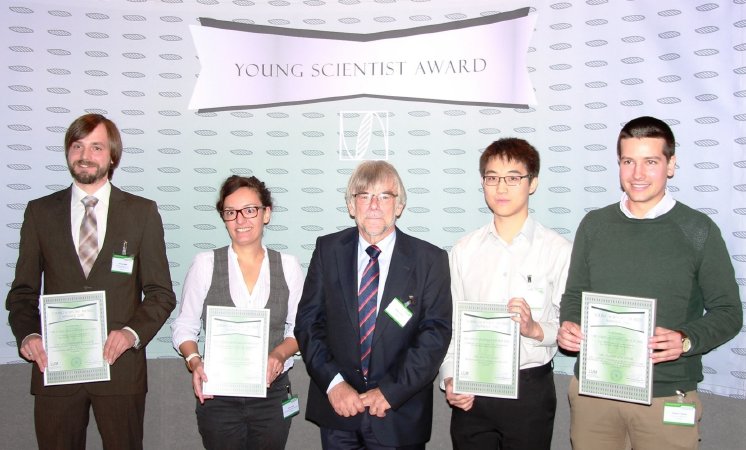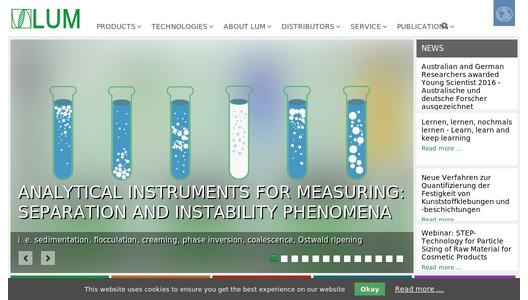“On behalf of all workshop attendees and the entire jury, I would like to thank all 10 applicants from six countries, who submitted very interesting contributions“, Prof. Dr. Lerche, scientific chairman of the conference and president of the jury, sums up. ”Four aspirants were nominated for the prize, based on the excellent application documents, and invited to present their exciting results to the more than 80 participants from 16 countries.“
Ms. Dr. Johann Lacava, Leibniz-Institute for New Materials, Saarbrücken, presented her research results on the aging of nanoparticles and their effect on emulsions. In a very vivid talk, she demonstrated the use of the multi-wavelength dispersion analyser LUMiSizer for the in-situ observation of destabilization processes in emulsions in dependence of the emulsifier. In a further chapter she described the temporal influence of the aging on the precipitation of nanoparticles in suspensions.
Michel Vong (MSc.) from Empa Swiss Federal Laboratories for Materials Science and Technology characterized the sedimentation behaviour of new, eco-friendly, solid flame retardants in polyols using a LUMiSizer. This topic represents on the one hand the determination of dispersibility of solid materials as a direct measure for the quality control of milling processes, on the other hand the stability analysis, i.e. the determination of the long-term behaviour of dispersed particles. Based on his work, the industrial partner could achieve a significant product improvement.
The quantification of wastewater sludge dewatering from suitable routine LUMiFuge lab-scale tests was in the focus of the research activities of MSc. Samuel J. Skinner, Department of Chemical and Biomolecular Engineering, Particulate Fluids Processing Centre, The University of Melbourne, Australia. Aim of the work is the cost reduction for sludge treatment and disposal by correct dewatering modelling based on the experimental quantification using analytical LUM centrifuges. Combining lab-scale gravity settling, centrifugation in LUMiFuge and constant pressure filtration, Skinner quantified for 15 kinds of sludge the dewaterability and detected a strong correlation with the volatile solids contents.
The use of LUMiFuge and LUMiReader X-Ray permitted Skinner to quantify wall effects. His developed theory now allows for the inclusion of wall effects into the simulation of dewaterability. In future a better upscaling to industrial plants is enabled.
The fourth nominee Dipl.-Ing. Johannes Walter, Institute of Particle Technology (LFG) of Friedrich-Alexander-Universität Erlangen-Nürnberg, reported about “Nanoparticle Characterization – Transfer from Analytical Ultracentrifugation to the LUMiSizer“. Jury president Prof. Lerche highlighted in his laudation the extraordinary importance of the work for the investigation of nanoparticles by analytical centrifugation (AC), technically realized in LUMiSizer. By transfer of most calculation algorithms of analytical ultracentrifugation (AUC) onto the easier and more economic AC, the multidimensional nanoparticle characterization as new application area is now available to a significantly higher number of users.
Due to the very high quality of two applicants, this year the prize money was increased by LUM and two nominees got the prize. Samuel J. Skinner (Australia) and Johannes Walter (Germany) were equally awarded Young Scientist 2016.
To continue support and commitment in promoting young researchers from universities and academic institutions, LUM will award the next Young Scientist on the follow-up event International Conference and Workshop Dispersion Analysis & Materials Testing in January 2018, Prof. Lerche closed the session.
The scientific results were already published by the awardees:
S. Skinner et al.: Quantification of wastewater sludge dewatering. Water Research, 2015, 82, 2-13.
J. Walter et al.: New possibilities of accurate particle characterisation by applying direct boundary models to analytical centrifugation. Nanoscale, 2015, 7, 6574-6587


